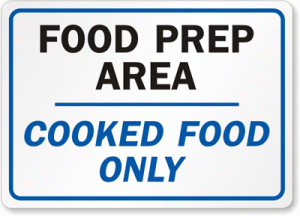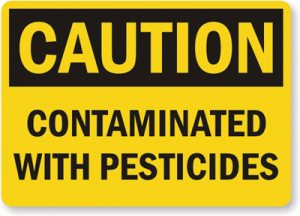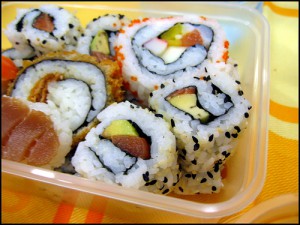Harmful chemicals in healthy foods

This might not be your biggest health concern the next time you’re out to eat (image via MySafetySign.com).
Does it make you cringe to wonder if your “sandwich artist” washed his hands before assembling your masterpiece, or if a restaurant is vigilant about keeping foods refrigerated and surfaces bacteria-free?
Well, take heart. That apple or container of homemade pasta salad in your lunch may pose a greater health threat.
Many foods that we eat everyday contain chemicals that, over time and in sufficient quantity, can contribute to health problems that would make a bout of food poisoning – from a restaurant’s wilting spinach salad, perhaps – seem like a minor sniffle.
Here are the most common – and most disturbing – types of chemicals found in food, and what you can do to reduce your exposure.
Pesticides
An apple a day may not keep the doctor away. In fact, apples were No. 1 on the Environmental Working Group’s annual list of most pesticide-contaminated produce. Strawberries, grapes and celery were next in line on the annual “Dirty Dozen” list, which is compiled from pesticide residue tests conducted on washed or peeled produce by the USDA and FDA.

Unfortunately, conventionally grown produce doesn’t come with this warning (image via MySafetySign.com).
Pesticides are applied to conventionally grown crops to kill insects and fungi, but leave a residue that’s been shown to damage human health as well: increasing cancer risk, impairing the brain and nervous system, disrupting the endocrine system and causing birth defects, according to the World Health Organization.
To avoid toxic chemicals entirely, go with organic produce that is grown without the use of synthetic chemicals or fertilizers – and make sure it has the USDA’s “Organic” sticker.
Antibiotics
Meat lovers, beware. Low levels of these chemical substances are routinely given to pigs, cows, poultry and other livestock to make them grow faster and to prevent infection in the crowded and often unsanitary conditions.
It’s so common, in fact, that 73 percent of the antibiotics sold in the U.S. go to food-producing animals – the remainder is prescribed to treat sick people, according to a report released this year by the Pew Campaign on Human Health and Industrial Farming.
So antibiotics breed fat and healthy animals – what’s the problem? Growing evidence shows their routine use also is breeding antibiotic-resistant bacteria and drug-resistant human illnesses. It’s enough of a concern that Canada and some European countries have banned non-medical antibiotic use in livestock.
BPA
Perhaps the most startling question surrounding this industrial chemical isn’t whether we ingest it – it’s how much is needed to do damage.
The Centers for Disease Control’s most recent report on “Human Exposure to Environmental Chemicals” found BPA in the urine of all the study participants – and that includes children as young as six.

Spot the health hazard: Here’s a clue … it isn’t the raw fish (photo by zone41.net).
Bisphenol A, or BPA, is an “endocrine disrupter” – this means it “may interfere with the production or activity of hormones in the human endocrine system,” according to the National Library of Medicine’s “Tox Town” website.
It’s commonly found in polycarbonate – a type of plastic used to make food and drink containers – and in epoxy resins, which are the linings you find inside many canned foods, and leaches into the food or drink.
While the CDC’s position regarding the health effects of ingesting low levels of BPA is “unknown,” studies from around the world have reported a link to reproductive disorders in adults and brain development issues in children.
An easy switch to reduce your ingestion of BPA is to use food and drink containers marked “BPA-free,” or switch to glass containers.
Additives
Chemicals are intentionally added to processed foods to enhance the taste or appearance or prolong its shelf-life, and they’re proliferous. Because a food manufacturer can make its own determination that a chemical is “Generally Recognized As Safe” (GRAS), Pew estimates that more than 3,000 of the estimated 10,000 substances “allowed” in human food were never reviewed by the FDA, and 1,000 are entirely unknown to the FDA and the public.
While the cancer-causing concerns of many additives have been studied and debunked, it’s also been recognized that some can elicit allergy-like reactions in some people. These include aspartame (the artificial sweetener commonly used in diet beverages) sulfites (found in wine and once used to perk up the look of fresh produce, before being banned by the FDA) and preservatives such as parabens and nitrates.
To reduce your exposure to additives, read food labels carefully, and limit your consumption of processed food.
Category: Chemicals, Food Safety











